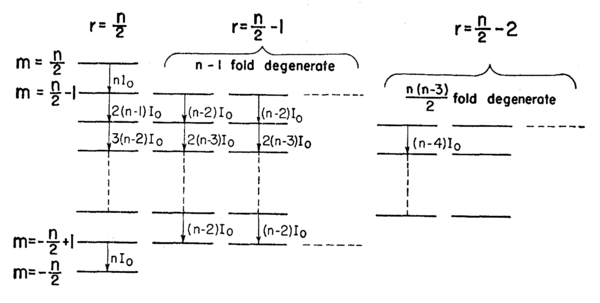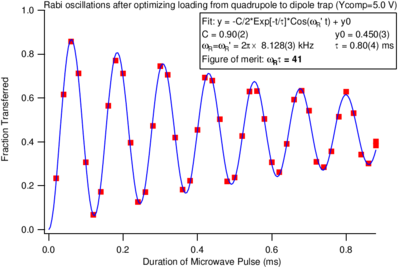Difference between revisions of "Quantized spin in a magnetic field"
imported>Ketterle |
imported>Hmiyake |
||
| (4 intermediate revisions by 2 users not shown) | |||
| Line 78: | Line 78: | ||
<blockquote> | <blockquote> | ||
::[[Image:resonances-two-level.png|thumb|500px|none|]] | ::[[Image:resonances-two-level.png|thumb|500px|none|]] | ||
| − | Equivalence of two-level system with spin-<math>1/2</math>. Note that for | + | {fig:two_level_spin_half} Equivalence of two-level system with spin-<math>1/2</math>. Note that for |
<math>\gamma>0</math> the spin-up state (spin aligned with field) is the ground state. For an electron, with <math>\gamma<0</math>, spin-up is the excited state. Be careful, as both conventions are used in the literature. | <math>\gamma>0</math> the spin-up state (spin aligned with field) is the ground state. For an electron, with <math>\gamma<0</math>, spin-up is the excited state. Be careful, as both conventions are used in the literature. | ||
</blockquote> | </blockquote> | ||
| Line 197: | Line 197: | ||
where have used the Pauli spin matrices <math>\sigma_x</math>, <math>\sigma_y</math>. The full | where have used the Pauli spin matrices <math>\sigma_x</math>, <math>\sigma_y</math>. The full | ||
Hamiltonian is thus given by | Hamiltonian is thus given by | ||
| + | |||
| + | :{eq:dressed_atom_hamiltonian} | ||
:<math> | :<math> | ||
\hat{H}=\frac{\hbar}{2} | \hat{H}=\frac{\hbar}{2} | ||
| Line 205: | Line 207: | ||
</math> | </math> | ||
This is the famous "dressed atom" Hamiltonian in the so-called "rotating wave | This is the famous "dressed atom" Hamiltonian in the so-called "rotating wave | ||
| − | approximation". Its eigenstates and eigenvalues provide a very elegant, very | + | approximation". However, note that in the treatment here there are no approximations; it is exact. Its eigenstates and eigenvalues provide a very elegant, very |
intuitive solution to the two-state problem. | intuitive solution to the two-state problem. | ||
| + | |||
| + | === Solution of the Schrodinger Equation for Spin-1/2 in the Rotating Frame === | ||
=== Solution of the Schrodinger Equation for Spin-1/2 in the Interaction Representation === | === Solution of the Schrodinger Equation for Spin-1/2 in the Interaction Representation === | ||
Latest revision as of 20:51, 19 February 2010
Contents
- 1 Equation of Motion for the Expectation Value
- 2 The Two-Level System: Spin-1/2
- 3 Matrix form of Hamiltonian
- 4 Solution of the Schrodinger Equation for Spin-1/2 in the Rotating Frame
- 5 Solution of the Schrodinger Equation for Spin-1/2 in the Interaction Representation
- 6 "Rapid" Adiabiatic Passage (quantum treatment)
Equation of Motion for the Expectation Value
For the system we have been considering, the Hamiltonian is
Recalling the Heisenberg equation of motion for any operator is
where the last term refers to operators with an explicit time dependence, we have in this instance
Using with the Levi-Civita symbol , we have
or in short
These are just like the classical equations of motion \ref{eq:classical_precession_in_static_field}, but here they describe the precession of the operator for the magnetic moment or for the angular momentum about the magnetic field at the (Larmor) angular frequency .
Note that:
- Just as in the classical model, these operator equations are exact; we have not neglected any higher order terms.
- Since the equations of motion hold for the operator, they must hold for the expectation value
- We have not made use of any special relations for a spin- system, but just the general commutation relation for angular momentum. Therefore the result, precession about the magnetic field at the Larmor frequency, remains true for any value of angular momentum .
- A spin- system has two energy levels, and the two-level problem with coupling between two levels can be mapped onto the problem for a spin in a magnetic field, for which we have developed a good classical intuition.
- If coupling between two or more angular momenta or spins within an atom results in an angular momentum , the time evolution of this angular momentum in an external field is governed by the same physics as for the two-level system. This is true as long as the applied magnetic field is not large enough to break the coupling between the angular momenta; a situation known as the Zeeman regime. Note that if the coupled angular momenta have different gyromagnetic ratios, the gyromagnetic ratio for the composite angular momentum is different from those of the constituents.
- For large magnetic field the interaction of the individual constituents with the magnetic field dominates, and they precess separately about the magnetic field. This is the Paschen-Back regime.
- An even more interesting composite angular momentum arises when two-level atoms are coupled symmetrically to an external field. In this case we have an effective angular momentum for the symmetric coupling:
Level structure diagram for two-level atoms in a basis of symmetric states \cite{Dicke1954}. The leftmost column corresponds to an effective spin- object. Other columns correspond to manifolds of symmetric states of the atoms with lower total effective angular momentum.
- Again the equation of motion for the composite angular momentum is a precession. This is the problem considered in Dicke's famous paper \cite{Dicke1954}, in which he shows that this collective precession can give rise to massively enhanced couplings to external fields ("superradiance") due to constructive interference between the individual atoms.
The Two-Level System: Spin-1/2
Let us now specialize to the two-level system and calculate the time evolution of the occupation probabilities for the two levels.
{fig:two_level_spin_half} Equivalence of two-level system with spin-. Note that for the spin-up state (spin aligned with field) is the ground state. For an electron, with , spin-up is the excited state. Be careful, as both conventions are used in the literature.
We have that
where in the last equation we have used the fact that . The signs are chosen for a spin with , such as a proton (Figure \ref{fig:two_level_spin_half}). For an electron, or any other spin with , the analysis would be the same but for the opposite sign of and the corresponding exchange of and . If the system is initially in the ground state, (or the spin along , ), the expectation value obeys the classical equation of motion \ref{eq:classical_rabi_flopping}:
- {eqn:rabi_transition_probability}
Equation \ref{eqn:rabi_transition_probability} is the probability to find system in the excited state at time if it was in ground state at time . Figure \ref{fig:rabi_signal} shows a real-world example of such an oscillation.
{fig:rabi_signal} Rabi oscillation signal taken in the Vuleti\'{c} lab shortly after this topic was covered in lecture in 2008. The amplitude of the oscillations decays with time due to spatial variations in the strength of the drive field (and hence of the Rabi frequency), so that the different atoms drift out of phase with each other.
Matrix form of Hamiltonian
With the matrix representation
we can write the Hamiltonian associated with the static field as
where is the Larmor frequency, and
is a Pauli spin matrix. The eigenstates are , with eigenenergies . A spin initially along , corresponding to
evolves in time as
which describes a precession with angluar frequency . The field , rotating at in the plane corresponds to
where have used the Pauli spin matrices , . The full Hamiltonian is thus given by
- {eq:dressed_atom_hamiltonian}
This is the famous "dressed atom" Hamiltonian in the so-called "rotating wave approximation". However, note that in the treatment here there are no approximations; it is exact. Its eigenstates and eigenvalues provide a very elegant, very intuitive solution to the two-state problem.
Solution of the Schrodinger Equation for Spin-1/2 in the Rotating Frame
Solution of the Schrodinger Equation for Spin-1/2 in the Interaction Representation
The interaction representation consists of expanding the state in terms of the eigenstates , of the Hamiltonian , including their known time dependence due to . That means we write here
Substituting this into the Schrodinger equation
then results in the equations of motion for the coefficients
Where we have used the matrix form of the Hamiltonian, \ref{eq:dressed_atom_hamiltonian}. Introducing the detuning , we have
The explicit time dependence can be eliminated by the sustitution
As you will show (or have shown) in the problem set, this leads to solutions for given by
with two constants that are determined by the initial conditions. For we find
as already derived from the fact that the expectation value for the magnetic moment obeys the classical equation.
"Rapid" Adiabiatic Passage (quantum treatment)
(in the works)
The quantum mechanical treatment yields a probability for non-adiabatic transition (probability for the magnetic moment not following the magnetic field) given by
in agreement with the qualitative classical criterion derived above.


![{\displaystyle {\frac {d}{dt}}{\hat {O}}={\frac {i}{\hbar }}\left[{\hat {H}},{\hat {O}}\right]+{\frac {\partial {\hat {O}}}{\partial t}}}](https://wikimedia.org/api/rest_v1/media/math/render/svg/ae5069cad777556e25ef2674f2ed7f1fbdc641a0)
![{\displaystyle {\frac {d}{dt}}{\hat {\mu }}_{k}=\gamma {\frac {d}{dt}}{\hat {L}}_{k}={\frac {i\gamma }{\hbar }}\left[{\hat {H}},{\hat {L}}_{k}\right]=-{\frac {i\gamma ^{2}}{\hbar }}B_{0}\left[{\hat {L}}_{z},{\hat {L}}_{k}\right]}](https://wikimedia.org/api/rest_v1/media/math/render/svg/31c5220d2321caf92920986550a99c6ba69fb523)
![{\displaystyle \left[{\hat {L}}_{k},{\hat {L}}_{l}\right]=i\hbar \epsilon _{klm}{\hat {L}}_{m}}](https://wikimedia.org/api/rest_v1/media/math/render/svg/5b0dce00bc29fe901e80ab62151d3d46ed0adb58)






























































